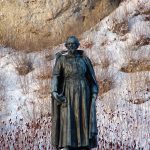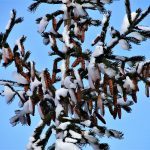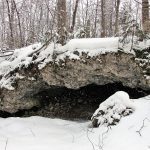
 Winter on Mackinac Island is a special time of year. The sun sets early, temperatures fall, and a crust of ice forms along the lakeshore. By late January or February, perhaps an “ice bridge” will form between the island and Saint Ignace. In the meantime, on a visit to Marquette Park, you’ll find that lilac blooms and bugle calls have been replaced by a bright, snowy stillness. On especially frigid days, your imagination may conjure Father Marquette stepping right off his pedestal, if he could just find a way to thaw out a little.
Winter on Mackinac Island is a special time of year. The sun sets early, temperatures fall, and a crust of ice forms along the lakeshore. By late January or February, perhaps an “ice bridge” will form between the island and Saint Ignace. In the meantime, on a visit to Marquette Park, you’ll find that lilac blooms and bugle calls have been replaced by a bright, snowy stillness. On especially frigid days, your imagination may conjure Father Marquette stepping right off his pedestal, if he could just find a way to thaw out a little.


Bruce Horsfall (1908).
Leaving downtown, the winter woods invite you to explore. Some years, the island is visited by flocks of red or white-winged crossbills. As its name implies, this unusual songbird has a highly specialized beak which crosses at the tip. This adaptation equips a crossbill with a perfect tool for slipping between hard, woody scales of spruce and pine cones. Under each scale, the bird finds a single, tiny seed which is quickly removed with a flick of the tongue. Standing under a spruce tree while a flock of crossbills feeds high above is a unique experience. Discarded bits of seed drift to the ground like softly-falling spruce snow.


While the North Woods are quiet this time of year, lucky explorers may enjoy other animal encounters. Both cottontail rabbits and snowshoe hares live year-round on Mackinac Island. While the fur coat of a cottontail grows a bit thicker, it remains a tawny brown. The winter coat of a larger snowshoe hare, however, turns white to blend with the snow. While they both take shelter in the thickest underbrush, these crafty creatures may flush and scurry past as you glide by on cross-country skis or snowshoes. Look for hares and rabbits along field edges, especially near the Mackinac Island airport. Even if they remain undercover, you still may discover their tracks in the snow.

to the muted winter landscape.

Exploring fields near the airport might leave you wondering if the word “windchill” was invented on Mackinac Island! Return to the trees by following nearby trails and enjoy a visit to Cave-of-the-Woods, one of the island’s oldest limestone formations. Persistent wave action formed this low opening about 10,000 years ago when this rocky outcrop rested on a prehistoric beach of ancient Lake Algonquin. The rounded cave floor was sculpted as the erosive power of water cut through softer material in the limestone mass. Today, this spot lies 140 feet above modern Lake Huron, providing shelter as you watch snowflakes fall and experience the quiet beauty of winter on Mackinac Island.









